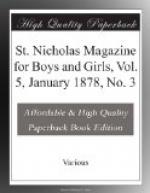A TABLE-COVER.
A really charming cover for a small table can be made in this way: Cut a square—or oblong, as the case may be—of that loosely woven linen which is used for glass-towels, making it about four inches larger all round than the table it is meant to fit. Pale yellow or brown is the best color to select. Ravel the edges into a fringe two inches deep; then, beginning two inches within the edge, draw the linen threads all round in a band an inch and three-quarters wide. Lace the plain space thus left with dark-red ribbon of the same width, woven in and out in regular spaces, and at each corner tie the ribbon in a graceful knot with drooping ends.
ANOTHER TABLE-COVER.
This cover is made of pale-brown Turkish toweling. Cut a piece of the size to suit your table, and baste all round it, first a row of scarlet worsted braid, then of olive, then of yellow, leaving spaces each an inch and a half wide between the rows. Cat-stitch the braids down on both edges with saddlers’ silk, and feather-stitch between them in silks, choosing colors which harmonize, and turning the whole into a wide stripe brilliant and soft at the same time. The choice and placing of the colors will be excellent practice for your eye, and after a little while you will be able to tell, as soon as a couple of inches are done, if you are putting the right tint into the right place. It is infinitely more interesting to feel your way thus through a piece of work than to follow any set pattern, however pretty, and it is far more cultivating to the taste.
A PAPER TRANSPARENCY.
Take a piece of white, or tinted, or silver paper, exactly ten and a half inches square. Fold it double diagonally. Fold it double again. Fold it double once more.
You will now have a triangular-shaped form of eight thicknesses. Now lay this folded piece on a pine table, or on a smooth piece of pine board. Next, lay evenly over it, so that it will fit exactly, the “pattern of transparency,” or an exact tracing from it. When so placed, secure them firmly to the board by pins driven in at each corner. Now, with a very sharp pen-knife follow and cut through to the board the lines of the pattern, so as to cut out all the portions that show black in the design. When this is all done, pull out the pins, open your folded paper, and you will have a square form beautifully figured in open-work. It should be laid between two sheets of white paper and carefully pressed with a hot iron, and then it can be lined with black or fancy tissue paper, and hung against a pane in the window as a “transparency;” or you may use it as a picture-frame, inserting an engraving or photograph in the center.




